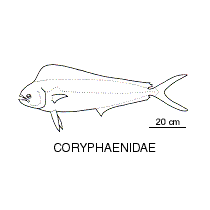- Classification
- ACTINOPTERYGII
- PERCIFORMES
- CORYPHAENIDAE
-
Fish Classification
-
Class
ACTINOPTERYGII Ray-finned fishes -
Order
PERCIFORMES Perches and allies -
Family
CORYPHAENIDAE Dolphinfishes -
Genera
Coryphaena(2)
Family CORYPHAENIDAE
Streamlined oceanic fishes, with an elongate, very compressed body, a single long-based dorsal fin, a deeply-forked tail and a blunt forehead that becomes very steep in adult males
Dolphinfishes are noted for their brilliant iridescence and variable colours. They are highly-prized by anglers and are usually caught on lures trolled near the surface.
More Info
|
Family Taxonomy |
The family contains a single genus with two species, both found worldwide mostly in tropical and subtropical seas, including in Australian waters. |
|
Family Distribution |
Found worldwide in tropical and warm temperate oceans; Pelagic, surface dwellers in tropical and warm temperate oceanic waters worldwide, rarely venturing inshore; often aggregate beneath floating debris.Dolphinfishes are pelagic, usually cruising near surface waters, and aggregating around oceanic islands or near large floating objects, including ships. |
|
Family Description |
Moderate to large-sized oceanic fishes with a long, compressed body, large eyes, an almost vertical snout, long-based dorsal and anal fins extending to the narrow tail base, and a deeply forked tail. The dorsal fin arises on the head above the gill cover, the pectoral and pelvic fins are short, and the pelvics fold back into grooves on the abdomen. The body is covered in small, cycloid scales, and the lateral line has a distinct curve above the pectoral fin. Adult males develop a bony crest on the forehead. |
|
Family Size |
Maximum length 2 metres, and a weight of about 40 kg. |
|
Family Colour |
Variably and brilliantly coloured, mostly metallic blue‑green above, silvery‑golden below, but flashing iridescent colours in accordance with behavioural states; dorsal fin dark green to deep blue; other fins usually yellow to orange; colours fade rapidly after death. |
|
Family Feeding |
Very fast swimmer feeding principally upon schools of flyingfishes and garfishes, frequently leaping from water when hunting prey or avoiding predators. |
|
Family Commercial |
Important commercially and recreationally, and considered excellent eating. Dolphinfishes are highly-prized by anglers using lures trolled near the surface. |
|
Family Remarks |
|
|
Author |
Dianne J. Bray |
References
Collette, B.B. 1999. Family Coryphaenidae. pp. 2656-2658 in Carpenter, K.E. & Niem, T.H. (eds). The Living Marine Resources of the Western Central Pacific. FAO Species Identification Guide for Fisheries Purposes. Rome : FAO Vol. 4 2069-2790 pp.
Gibbs, R.H. & Collette, B.B. 1959. On the identification, distribution and biology of the dolphins, Coryphaena hippurus and C. equiselis. Bulletin of Marine Science of the Gulf and Caribbean 9(2): 117-152 figs 1-18.
Gray, K.N., McDowell, J.R., Collette, B.B. & Graves, J.E. 2009. A molecular phylogeny of the remoras and their relatives.Bulletin of Marine Science 84(2): 183-198.
O'Toole, B. 2002. Phylogeny of the species of the superfamily Echeneoidea (Perciformes: Carangoidei: Echeneidae, Rachycentridae, and Coryphaenidae), with an interpretation of echeneid hitchhiking behaviour. Canadian Journal of Zoology 80(4): 596-623.
Palko, B.J., Beardsley, G.L. & Richards, W.J. 1982. Synopsis of the biological data on dolphin fishes, Coryphaena hippurusLinnaeus and Coryphaena equiselisLinnaeus. NOAA Tech. Rep. NMFD circular 443, 28 pp.













